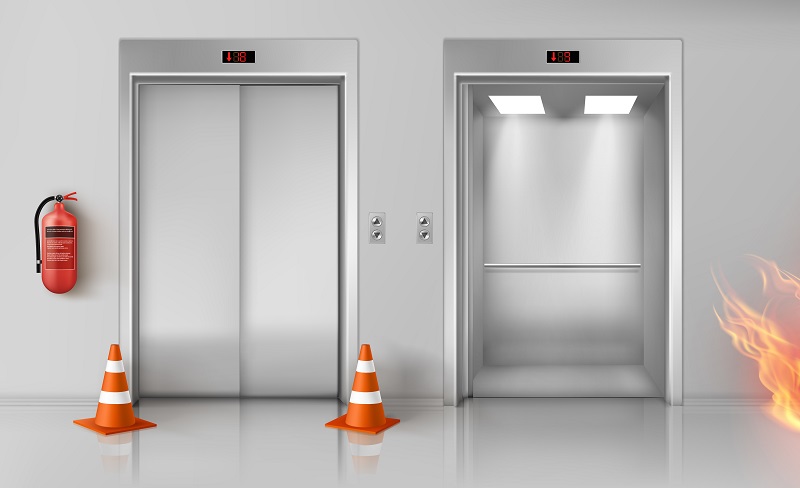Did you know that in 2022, fires in commercial properties caused over $3.7 billion in damages? Data from the U.S. Fire Administration shows a 23% increase in dollar losses over the past decade. Given these alarming statistics, property owners and managers must find ways to mitigate such risks.
Preventing fires not only minimizes threats but also helps protect the planet by reducing the release of dangerous pollutants into the air and limiting damage to natural resources.
Fire-rated doors play a crucial role in this regard. This article will explore how these doors reduce property damage and ensure compliance with regulations, making them critical for any commercial building.
What Are Fire-Rated Doors?
Fire-rated doors are building components designed to hold back fire and smoke for a specific period. They have a fire-resistant core, a sturdy frame, and specialized hardware. Unlike standard doors, these doors withstand high temperatures and prevent flames from spreading rapidly.
The Fire-Rating System
The fire-rating scale indicates how long a door can resist fire exposure under standard testing conditions. This typically ranges from 45 minutes for light commercial applications to 3 hours for high-risk areas.
A 45-minute rating suits most corridors, while 1-hour doors are commonly seen in stairwells. Areas with severe hazards require at least a 1½-hour rating, like the BAC-PFN-GYP fire rated access door.
Several factors determine a door’s fire rating. The core material—such as mineral board, gypsum, or steel—forms the primary defense. Additional features include intumescent seals that expand under heat and specialized hardware rated for fire exposure.
While these materials are key parts that make up for a door’s fire rating, proper installation is equally important. When done correctly, it helps support the door’s effectiveness and the wall or ceiling’s fire rating.
The Role of Fire-Rated Doors in Commercial Buildings
Commercial buildings often have trouble managing fires. Due to their complex layouts, high occupancy rates, and diverse use of spaces, these structures can be particularly vulnerable to fire hazards. Fire-rated doors address these challenges through several functions:
Containment of Fire and Smoke
Fire-rated doors act as barriers, effectively compartmentalizing buildings. Their construction creates a seal that prevents flames and smoke from progressing to other parts of the buildings for a limited time.
However, property owners and managers must perform regular maintenance to ensure these containment features stay functional. This includes checking seals, testing closing mechanisms, and verifying proper latching.
Structural Integrity
Extreme heat and damage can compromise a building’s structural integrity. Fire-rated doors can help preserve this integrity by keeping fire and smoke from rapidly reaching load-bearing components. Additionally, they contribute to building code compliance, which often mandates using fire-rated doors in specific areas.
Evacuation and Emergency Response
One study highlights that smoke can hinder evacuation by reducing visibility and causing disorientation. Since fire-rated doors contain smoke within a specific area, they provide a clear path for building occupants to evacuate safely and orderly. They also give firefighters more time to extinguish the flames and reduce damage.
Insurance and Liability Considerations
Here’s a benefit many people overlook: fire-rated doors can help save money. Most insurance companies reward property owners with attractive discounts when they take fire measures seriously—fire-rated doors being part of that list.
But the financial benefits don’t stop there. Having fire-rated doors can help mitigate potential legal liabilities associated with inadequate fire measures.
Commercial Building Requirements
Fire-rated door requirements vary depending on the specific location and type of commercial building. To ensure compliance, consult local building codes and fire regulations.
Location-Specific Requirements
Fire-rated doors are often needed for specific areas within a building, such as:
- Corridors: When fire breaks out, these common walkways can quickly turn into paths that spread smoke and flames.
- Mechanical Rooms: These rooms often house essential equipment and can be a source of ignition.
Building Type Considerations
Every building has its own needs. Let’s look at what this means for different places:
- High-Rise Structures: With so many floors and high occupancy, these buildings face unique challenges. Fire-rated doors help free each floor of smoke and give people clear paths to escape in emergencies.
- Healthcare Facilities: Safe evacuation becomes even more critical for patients who can’t move quickly. These buildings need fire-rated doors to contain smoke and flames, even for several minutes.
- Educational Institutions: Science labs with Bunsen burners, art rooms with hot kilns, and aging wiring systems can all start fires. Fire-rated doors can help stop flames from spreading between different building areas.
It’s important to note that building codes and regulations can vary across different jurisdictions. Consulting with local authorities and experts is the best way to ensure compliance with all applicable requirements.
Factors to Consider When Choosing a Fire-Rated Door
Selecting the right fire-rated door for a commercial building involves several key factors:
Specific Fire Hazards and Risks
Understanding the specific fire hazards and risks associated with a commercial building is crucial. For example, buildings with hazardous materials may require doors with higher fire ratings and added safety features.
Door Size, Type, and Location
The door’s size, type, and location will influence its fire-rating requirements. Larger doors, such as those in warehouses or loading docks, may need higher fire ratings to prevent the rapid spread of fire.
Aesthetic Considerations
While functionality matters, it’s important to consider the aesthetic appeal of fire-rated doors. After all, they come in various styles and finishes to complement the building’s design.
Specific Needs
In addition to fire resistance, you may have specific needs for the doors, such as:
- Acoustic Ratings: The doors can block unwanted noise, creating a more peaceful and productive space in offices and other areas.
- Insulation: Built with thermal protection in mind, these access doors help slash energy bills by preventing heat loss and maintaining comfortable temperatures.
- Security Features: The robust hardware and locks built into these doors help protect properties and provide peace of mind against unauthorized entry.
Conclusion
Fire-rated doors are essential to any commercial building. They provide many benefits, including containment of fire and smoke, protection of structural integrity, facilitation of safe evacuation, and potential cost savings. Prioritizing fire measures and investing in fire-rated doors can help you reduce the risk of property damage and potential legal liabilities.




